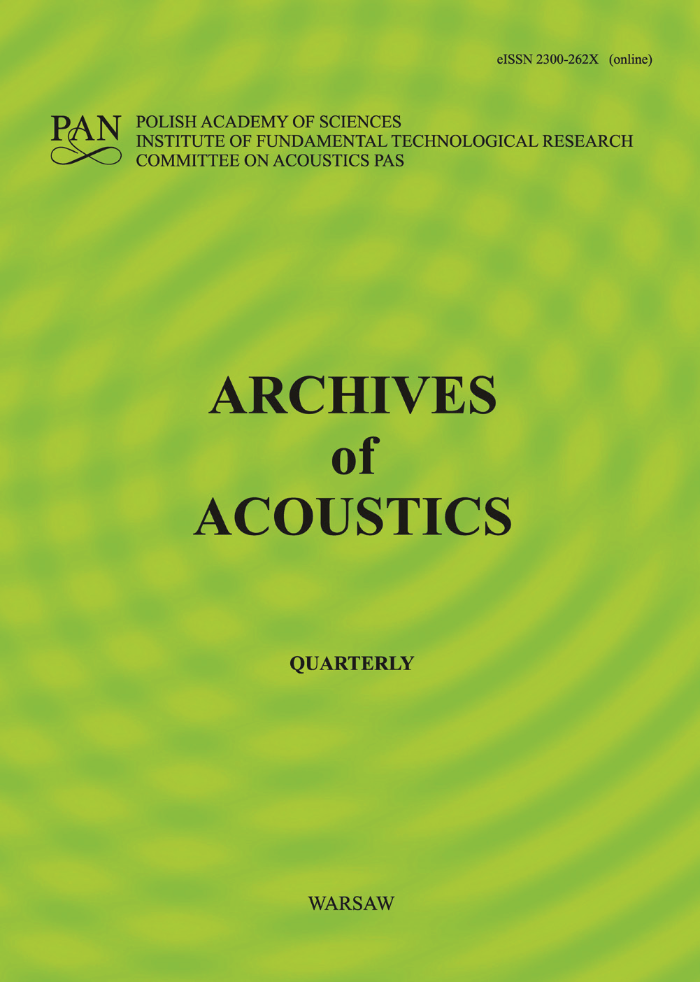Simulation and Experiment of a Medium-Distance Underwater Ultrasonic Wireless Power Transfer System
Abstract
This paper focuses on ultrasonic wireless power transfer (UWPT), a form of underwater wireless power transfer (WPT) using acoustic (ultrasonic) waves. We propose an ultrasonic transducer designed based on the Langevin transducer model, along with its equivalent circuit model for underwater transmission, tailored for efficient medium-distance underwater WPT. The performance of this transducer is simulated and analyzed using the acoustic-piezoelectric structure module in COMSOL. The results demonstrate that the transducer exhibits excellent underwater transmission characteristics. Additionally, an equivalent circuit model of the underwater UWPT system is developed and analyzed to characterize its transmission properties. For validation, a prototype UWPT is fabricated. At a 35 cm separation between the transmitter and receiver, the transmitter power is 2.5 W. With a 1.2 kΩ load, the received root mean square (RMS) voltage is measured at 22.8 V, corresponding to a received power of 433mW and a transmission efficiency of 17 %. These results verify the proposed model, demonstrate a significant improvement in the transmission distance of underwater UWPT systems, and confirm the feasibility of medium-distance UWPT.
Keywords:
underwater, wireless power transfer (WPT), ultrasonic, ultrasonic transducerReferences
- Bao X. et al. (2008), High-power piezoelectric acousticelectric power feedthru for metal walls, [in:] Proc. SPIE 6930, Industrial and Commercial Applications of Smart Structures Technologies 2008, https://doi.org/10.1117/12.776473.
- Basaeri H., Yu Y., Young D., Roundy S. (2019), A MEMS-scale ultrasonic power receiver for biomedical implants, IEEE Sensors Letters, 3(4): 2501104, https://doi.org/10.1109/lsens.2019.2904194.
- Callens D., Bruneel C., Assaad J. (2004), Matching ultrasonic transducer using two matching layers where one of them is glue, NDT & E International, 37(8): 591–596, https://doi.org/10.1016/j.ndteint.2004.03.005.
- Chen X., Xu K., Mou X., Li G. (2018), Comparison of inductively coupled and ultrasonically coupled wireless energy transmission technologies in seawater [in Chinese], Journal of Electrical Machines and Control, 22(03): 9–16, https://doi.org/10.15938/j.emc.2018.03.002.
- Fai L.H., Dai X., Hu A. (2015), Electrical modeling of a wireless ultrasonic power transfer system [in Chinese], Chinese Journal of Electrical Engineering, 30(19): 85–89, https://doi.org/10.19595/j.cnki.1000-6753.tces.2015.19.012.
- Fei C.L. et al. (2015), Design of matching layers for high-frequency ultrasonic transducers, Applied Physics Letters, 107(12): 123505, https://doi.org/10.1063/1.4931703.
- Guida R., Demirors E., Dave N., Melodia T. (2022), Underwater ultrasonic wireless power transfer: A battery-less platform for the Internet of Underwater Things, IEEE Transactions on Mobile Computing, 21(5): 1861–1873, https://doi.org/10.1109/tmc.2020.3029679.
- Kim H.S. et al. (2022), Ferroelectrically augmented contact electrification enables efficient acoustic energy transfer through liquid and solid media, Energy & Environmental Science, 15(3): 1243–1255, https://doi.org/10.1039/d1ee02623b.
- Roes M.G.L., Duarte J.L., Hendrix M.A.M., Lomonova E.A. (2013), Acoustic energy transfer: A review, IEEE Transactions on Industrial Electronics, 60(1): 242–248, https://doi.org/10.1109/tie.2012.2202362.
- Roes M.G.L., Hendrix M.A.M., Duarte J.L. (2011), Contactless energy transfer through air by means of ultrasound, [in:] IECON 2011 – 37th Annual Conference of the IEEE Industrial Electronics Society, pp. 1238–1243, https://doi.org/10.1109/IECON.2011.6119486.
- Sanni A., Vilches A., Toumazou C. (2012), Inductive and ultrasonic multi-tier interface for low-power, deeply implantable medical devices, IEEE Transactions on Biomedical Circuits and Systems, 6(4): 297–308, https://doi.org/10.1109/tbcas.2011.2175390.
- Selfridge A.R. (1985), Approximate material properties in isotropic materials, IEEE Transactions on Sonics and Ultrasonics, 32(3): 381–394, https://doi.org/10.1109/t-su.1985.31608.
- Shin J. et al. (2014), Design and implementation of shaped magnetic-resonance-based wireless power transfer system for roadway-powered moving electric vehicles, IEEE Transactions on Industrial Electronics, 61(3): 1179–1192, https://doi.org/10.1109/tie.2013.2258294.
- Singer A., Robinson J.T. (2021), Wireless power delivery techniques for miniature implantable bioelectronics, Advanced Healthcare Materials, 10(17): 2100664, https://doi.org/10.1002/adhm.202100664.
- Song M. et al. (2021), Wireless power transfer based on novel physical concepts, Nature Electronics, 4(10): 707–716, https://doi.org/10.1038/s41928-021-00658-x.
- Valenta C.R., Durgin G.D. (2014), Harvesting wireless power: Survey of energy-harvester conversion efficiency in far-field, wireless power transfer systems, IEEE Microwave Magazine, 15(4): 108–120, https://doi.org/10.1109/mmm.2014.2309499.
- Xu K., Chen X., Liu D. (2015), Electrical impedance transformation technique for undersea ultrasonic coupled wireless energy transmission system [in Chinese], Chinese Journal of Electrical Engineering, 35(17): 4461–4467, https://doi.org/10.13334/j.0258-8013.pcsee.2015.17.022.
- Zhang Z., Pang H., Georgiadis A., Cecati C. (2019), Wireless power transfer – An overview, IEEE Transactions on Industrial Electronics, 66(2): 1044–1058, https://doi.org/10.1109/tie.2018.2835378.







